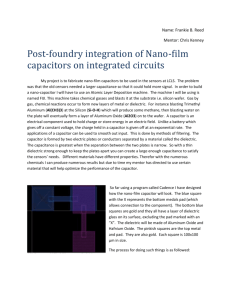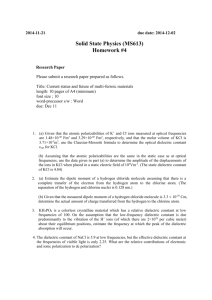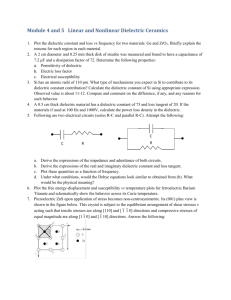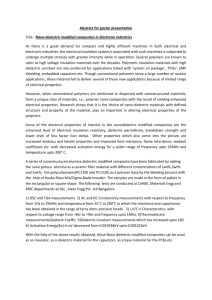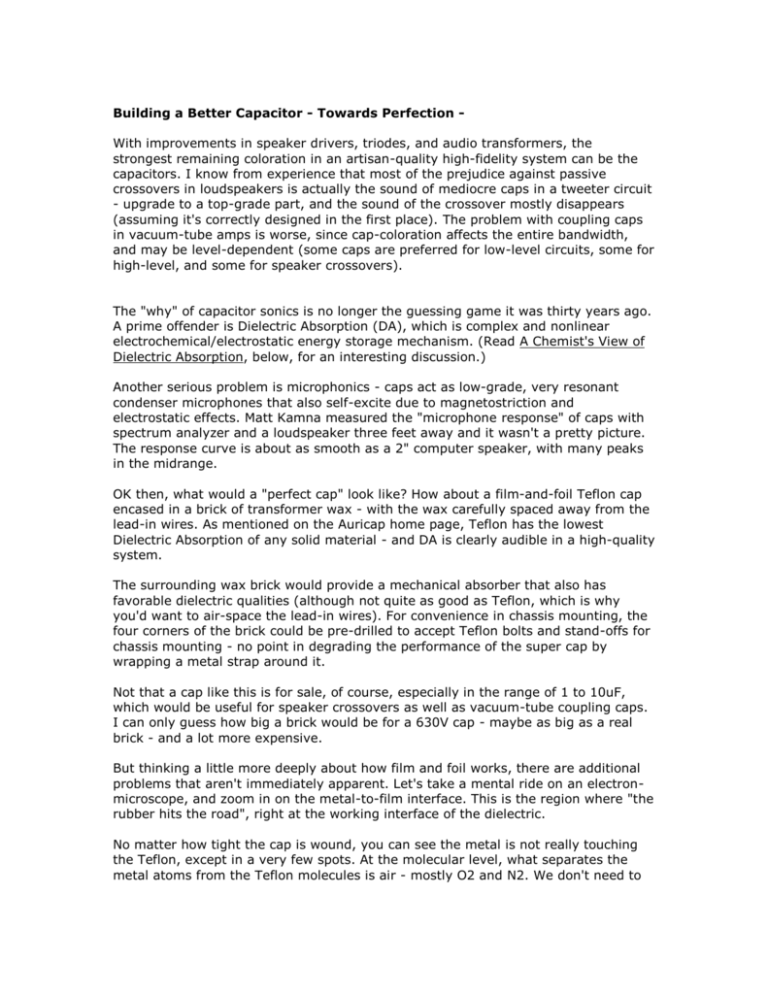
Building a Better Capacitor - Towards Perfection With improvements in speaker drivers, triodes, and audio transformers, the
strongest remaining coloration in an artisan-quality high-fidelity system can be the
capacitors. I know from experience that most of the prejudice against passive
crossovers in loudspeakers is actually the sound of mediocre caps in a tweeter circuit
- upgrade to a top-grade part, and the sound of the crossover mostly disappears
(assuming it's correctly designed in the first place). The problem with coupling caps
in vacuum-tube amps is worse, since cap-coloration affects the entire bandwidth,
and may be level-dependent (some caps are preferred for low-level circuits, some for
high-level, and some for speaker crossovers).
The "why" of capacitor sonics is no longer the guessing game it was thirty years ago.
A prime offender is Dielectric Absorption (DA), which is complex and nonlinear
electrochemical/electrostatic energy storage mechanism. (Read A Chemist's View of
Dielectric Absorption, below, for an interesting discussion.)
Another serious problem is microphonics - caps act as low-grade, very resonant
condenser microphones that also self-excite due to magnetostriction and
electrostatic effects. Matt Kamna measured the "microphone response" of caps with
spectrum analyzer and a loudspeaker three feet away and it wasn't a pretty picture.
The response curve is about as smooth as a 2" computer speaker, with many peaks
in the midrange.
OK then, what would a "perfect cap" look like? How about a film-and-foil Teflon cap
encased in a brick of transformer wax - with the wax carefully spaced away from the
lead-in wires. As mentioned on the Auricap home page, Teflon has the lowest
Dielectric Absorption of any solid material - and DA is clearly audible in a high-quality
system.
The surrounding wax brick would provide a mechanical absorber that also has
favorable dielectric qualities (although not quite as good as Teflon, which is why
you'd want to air-space the lead-in wires). For convenience in chassis mounting, the
four corners of the brick could be pre-drilled to accept Teflon bolts and stand-offs for
chassis mounting - no point in degrading the performance of the super cap by
wrapping a metal strap around it.
Not that a cap like this is for sale, of course, especially in the range of 1 to 10uF,
which would be useful for speaker crossovers as well as vacuum-tube coupling caps.
I can only guess how big a brick would be for a 630V cap - maybe as big as a real
brick - and a lot more expensive.
But thinking a little more deeply about how film and foil works, there are additional
problems that aren't immediately apparent. Let's take a mental ride on an electronmicroscope, and zoom in on the metal-to-film interface. This is the region where "the
rubber hits the road", right at the working interface of the dielectric.
No matter how tight the cap is wound, you can see the metal is not really touching
the Teflon, except in a very few spots. At the molecular level, what separates the
metal atoms from the Teflon molecules is air - mostly O2 and N2. We don't need to
worry about the N2, but the O2 is another story, since it will corrode the exposed
metal surface.
Metallic oxides create serious electrical problems. Aluminum is notoriously easy to
oxidize, acquiring a film minutes after it's removed from an acid-etch cleaning bath.
Copper oxidizes more slowly, but just as surely. Silver also oxidizes slowly.
I'm not an expert, but I know that aluminum oxide is considered a near-perfect
insulator, which is why it is the effective dielectric in electrolytic capacitors (the wet
electrolyte transports the charge electrochemically). Copper oxide is a semiconductor
diode, and was actually used in (inefficient) copper-oxide power rectifiers in the
Twenties. Silver oxide I know less about, but it is classed as a conductor, not a
semiconductor.
What's awkward about these metallic oxides is that they lie between the intended
dielectric - Teflon - and the mostly pure metal carrying the charge. For a little while,
a few areas of the metal foil may be free of oxidization, but it won't take long for
oxygen to creep between the windings of the capacitor and gradually oxidize all of
the metal foil surface area. To get the process started, it only takes an oxide layer
one molecule thick.
Not only that, the voltage breakdown of the metal-oxide layer is going to be different
in different areas of the metal foil, depending on how thick the oxidization is. Voltage
breakdown is something we care about, since the cap may or may not be used in a
dry circuit (not enough current to "punch-through" an oxide layer).
If punch-through does occur, it certainly won't be all over the surface area of the
metallic foil. It'll only be in pinpoint arc-over regions, where the oxidization is
thinnest and current flow the heaviest. Since the oxide layer is extremely thin, the
voltage breakdown potential will be low as well. (This isn't the same as voltage
breakdown of the intended dielectric, which happens at much higher voltages. This is
breakdown of the corrosion layer.)
Although surface corrosion on wires and transformer windings is troublesome, it can
be dealt with by adding an enamel or urethane coating on the wire as soon as it
emerges from the wire-drawing machine or an acid bath. (You can see how surface
corrosion is an intractable problem on bare-copper stranded wire. This is the great
advantage of Litz wire, which isolates each strand in its own insulated coating.)
This approach doesn't work as well for metal foils intended for capacitors. An
additional protective surface has dielectric properties of its own, and certain to be
less favorable than polypropylene or Teflon.
One possible technique - not easy to visualize - is to acid-clean the metal foil, keep it
in nitrogen gas, wind it into a cap in a pure-nitrogen atmosphere, and hermetically
seal the capacitor, taking special care to avoid oxygen incursion along the lead-in
wires. (Glass or ceramic encapsulation in a nitrogen atmosphere?) This sounds pretty
exotic, although it might be routine for aerospace-grade parts, where outgassing and
chemical migrations over time are a serious problem.
So in addition to the known problems with coloration from Dielectric Absorption in
the bulk dielectric, there are problems with thin-layer corrosion on the metal-foil
surface. Most plastics are nowhere close to gas-tight, especially along the vulnerable
lead-in area. I'm pretty sure corrosion begins within minutes of the cap being
assembled - if the metal isn't already corroded by the time it's used to assemble the
capacitor.
I'm getting suspicious of subjective "break-in" that take days or weeks to stabilize.
Anything that takes this long strongly suggests electrochemical reactions, although
relaxation and re-orientation of the grain structure might be possible as well. For
transformers, the cause is fairly obvious: the stress of winding the wire fractures the
grain structure of the wire at each bend around the winding former, and it takes
weeks or months for the winding stresses to be relieved. This is where cryogenic
treatment might be useful, making the tedious process of break-in unnecessary.
There could be stresses created by the high-tension foil-wrapping process in a
capacitor, and if this is present, cryogenic treatment can be useful. But it won't do
much for corrosion on the surface of the metal.
Maybe - just maybe - the superior, more transparent sonics of silver come down to
nothing more than a more benign corrosion layer than copper. Something to think
about.
© Lynn Olson 2002. All Rights Reserved.
On Capacitor Dielectric Materials - A Chemist's View
Karl A. Weber, Ph.D.
The fundamental function of a capacitor is to store opposite polarity electrostatic charges on a pair of
electrically isolated (insulated) conductive surfaces. The quantity of charge stored on each of these surfaces
is ideally directly proportional to their surface areas and inversely proportional to the distance between the
surfaces. Such a simple understanding needs to be refined to take into account the effect of the electric field
set up between the charged plates on the insulating material. In theory this concern could be avoided by
constructing capacitors without any material between: a vacuum.
Unfortunately, such high vacuum devices would be impractical. The next best insulating material is air
since it provides limited interacting material and a very high resistance. Air is only practical for the lowest
capacitances. Other insulating materials have included: paper/oil, minerals, ceramics, glasses, ceramic
corrosion layers on metals and plastic films. Any insulating material used in capacitors of identical
dimensions will increase the capacitance with respect to that of a vacuum.
The proportionality constant relating each material's capacitance enhancement over that of a vacuum is
known as its "dielectric constant." The dielectric constant is a measure of the extent to which the insulating
material's surface interacts with the electric field set up between the charged plates. The constant is
dependent on two molecular level properties: the permanent "dipole moment" and the "polarizability" or
the induced change in dipole moment due to the presence of an electric field. The permanent dipole
moment is the average over the various dipole moments given rise to by structural charge density
differences over intramolecular distances. The charge density differences result from the electronegativity
differences between the various atoms which comprise the molecular structure of the insulator.
Polarizability is the property which arises from changes in the molecular electron distribution induced by
the applied electric field. Both of these properties contribute to a net field, of opposite
orientation to the inducing electric field between the charged plates. The larger the dielectric constant, the
greater the induced field on the surface of the insulating material or "dielectric."
In A.C. applications, where signal handling is involved, factors which affect the rates of both
charging/discharging become key issues. Even though dielectrics with larger constants allow smaller
size/capacitance devices, the properties of such dielectrics contribute deleteriously to audio signal
processing. Where dielectrics with larger constants are employed, their larger dipole
moments/polarizabilities interact more strongly with the inter-plate field, resulting in a stronger induced
opposing field on the dielectric. When a capacitor is discharged across a load the polarized dipoles
thermally relax in a statistical manner, exhibiting a time decay, observed as a tailing decay of residual
current as complete discharge is approached. If the capacitor is suddenly discharged, allowed time to set
and then shunted across a load it will discharge a residual current (of the same polarity as the initial
charge). Upon dissipation of the bulk of the charge, the polarized dipoles on the dielectric thermally relax,
which results in a residual charge on the plates. The residual charge from dielectric relaxation is known as
the "dielectric absorption." When an audio signal is passed through a capacitor the dielectric absorption
prevents full charging and discharging of the capacitor at the frequency of the alternating current signal.
When the signal reverses the charging on the plates the dielectric absorption presents a lagging current of
the former polarity, a hysteresis effect results. This effect becomes more acute with increasing frequency.
Obviously now, not all dielectrics are equal. In audio applications it is desirable to seek the insulating
material with the lowest practical dielectric absorption; hence, lowest dielectric constant, barring size and
economics. Dielectric materials can be classified based on their relative polarity/polarizability properties,
which the dielectric constants and dielectric absorptivities parallel.
What follows is a qualitative categorization of dielectric materials in decreasing polarity/polarizability
based on chemical structure considerations (Dielectric constant data "K" given when available):
I. Metal oxide corrosion layers (electrolytic capacitors):
1) Tantalum oxide (K = 11)
2) Aluminum oxide (K = 7)
Both consist of polar metal oxide bonds possessing large permanent dipole
moments, polarizability factors are negligible.
II. Ceramics and Glasses:
1) Ceramics - typically alumina or aluminosilicates (K = 4.5 - thousands)
2) Glasses - typically borosilicate (K = 4-8.5)
Similarly, the polar inorganic oxide bonds in these materials have large
permanent dipole moments.
III. Minerals:
1) Mica (most common) - an alkali metal aluminosilicate, hydrate
(K = 6.5 - 8.7)
Same as II.
IV. A. Polymer films - functionally linked - ranked in order of decreasing functional linkage polarity
(brackets "[ ]" indicate guess based on functional group polarity):
1) Polyesters (ex. Mylar) - ester (K = 3.2 - 4.3)
2) [Kapton - ether and imide]
3) Polyamides (ex. Nylon) - amide (K = 3.14 -3.75)
4) Polycarbonate - carbonate (K = 2.9)
5) [PEEK - ether and ketone]
6) [Poly(phenylene oxide) - PPO - ether]
7) [Poly(phenylene sulfide) - PPS- thioether]
The members of the above list can essentially be ranked based on polarity considerations alone,
though polarizability considerations are significant for the latter members of the list.
B. Polymer films - carbon chain backbone - ranked in order of decreasing attached-group
polarity/polarizability:
1) Poly(vinyl chloride) - PVC - chloro-substituted (K = 3.3 - 4.55)
2) Poly(chlorotrifluoroethylene) - chloro- and fluoro-substituted (K = 2.48 - 2.76)
3) Poly(p-phenyleneethylene) - Parylene - exception to list phenyl ring in backbone (K = 2.65)
4) Polystyrene - phenyl-substituted (K = 2.54 - 2.56)
5) Polyethylene - essentially unsubstituted carbon chain (K = 2.3 - 2.37)
6) Polypropylene - methyl-substituted (K = 2.1)
7) Poly(tetrafluoroethylene) (ex. Teflon) - perfluoro-substituted (K = 2.0 - 2.1)
To rank the first two members of this list consideration must be given to both, polarity and
polarizability considerations. Polymer 2) is adequately fluorinated to cancel C-F bond polarities,
the C-Cl bonds are the prime contributors to its polarity. Since C-F bonds are not verypolarizable,
polymer 1) has a higher polarizability than polymer 2) and a correspondingly higher dielectric
constant. Polymers 3) and 4) can be ranked primarily on their polarizabilities, which are
significantly higher due to the pi-electrons in their phenyl moieties. Polymers 5 and 6 differ
mainly in that the methyl substituted chains are less prone to wrap against themselves due to steric
methyl-methyl interactions. In Teflon the C-F bond polarities essentially cancel since it is
completely fluorinated, and given that the C-F bonds are not very polarizable it exhibits overall
less polarizability than its unsubstituted carbon chain analogue, 5), polyethylene.
Based on polarization/dielectric constant considerations for minimization of dielectric absorption, the best
films for audio applications are teflon and polypropylene. Runners up would be polyethylene and
polystyrene, based on these considerations alone. Throughout this discussion, I have assumed that dielectric
absorption and the dielectric constant are directly correlated.
Apparently, when polarizability factors predominate, the time constant for relaxation of the field induced
dipole is critical. Otherwise, one would expect polypropylene to have a lower dielectric absorption than
polystyrene, which is not the observed result. This can be reasoned by re-examining what is being polarized
by the field in each. In the case of the polystyrene, the pi-electrons in the aromatic rings (which have been
modeled, in the past, as a "free electron gas") can orient electronically, with less mechanical change in the
polymer structure. Hence, it can relax faster. In contrast, the polarization of polypropylene involves more
mechanical change of the structure, and hence a slower relaxation rate.
Up to this point, I have only mentioned in passing paper/oil (paper-in-oil) capacitors. These classic devices
from "days of yore" are making a comeback in some audio circles - especially among tube connoisseurs.
Certainly, they are of interest. Unfortunately, they employ a composite dielectric that consists of a paper
spacer/absorbent saturated with an oil; therefore, they do not readily lend themselves to the present simple
analysis. Since the dielectric polarization primarily occurs on the surface of the dielectric material, in the
vicinity of the plates, the dielectric constant in such a capacitor would consist of a weighted average of two
dielectric constants: the most significant weighting attributed to the oil and the lesser weighting attributed
to the surface area of the fibrules of paper in contact with the metal plates. The weightings for each
dielectric component are not readily measurable. Hence, all that we know is that the contribution of the
paper cannot be neglected, since it acts as a supporting spacer for the tightly rolled foil plates and makes
intimate contact with them. One should measure the dielectric constant for each type of paper/oil
combination under consideration.
The most common combination is that of a petroleum derived mineral oil absorbed into kraft paper.
Common foils include aluminum and tin. More "exotic" variants on this theme, are those capacitors
distributed by a certain manufacturer/distributor in England (who’s name shall remain omitted here), which
consist of a vegetable oil/unspecified type paper dielectric and copper or silver foil plates. [It should be
noted that the same British manufacturer also sells a series of mylar film (K = 4)/foil capacitors for signal
handling: a pecular dielectric material for high cost/performance audio signal carrying applications.] The
nature of the plate metal is not nearly as important as that of the oil and the paper. Mineral oils, consist
mainly of saturated hydrocarbon oils and exhibit very low dielectric constants near K = 2. In contrast,
papers such as Kraft paper exhibit dielectric constants on the order of K = 4. If we assume a mere 10%
paper-plate contact, the composite dielectric constant would be near K = 2.2; which is similar to that of
polypropylene. The 10% figure is merely an arbitrary suggestion. Unfortunately, one would expect two
superimposed polarization thermal relaxation rates: that associated with the polar solid cellulosic paper
would be significantly slower than that for the non-polar liquid mineral oil. In contrast, the relaxation rate
for a non-polar polymer film such as polypropylene would be nearer that of mineral oil than that of paper;
and its relaxation characteristics would be more uniform due to its homogeneous nature. The use of
vegetable oil in place of the mineral oil only makes matters worse for the paper/oil composite dielectric;
since vegetable oil, as a fatty acid ester, would exhibit a dielectric constant in the vicinity of K = 3. If we
again assume 10% paper-foil contact, the composite dielectric constant would be near K = 3.1. (Perhaps
such capacitors might be better suited for the culinary arts!)


